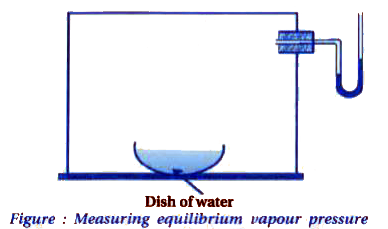Explain liquid-vapour equilibrium.
Process : We consider the example of a transparent box carrying a U-tube with mercury (manometer). Drying agent like anhydrous calcium chloride (or phosphorus penta-oxide) is placed for a few hours in the box. By doing this air in the box is free from vapour (moisture). (see fig.)
Now, after removing the drying agent by tilting the box on one side, a watch glass (or petri dish) containing water is quickly placed inside the box.

Observation : It will be observed that the mercury level in the right limb of the manometer slowly increases and finally attains a constant value.
Assumption : The observation shows that (i) In the beginning the pressure inside the box increases. (ii) After some time pressure inside the box becomes constant. (iii) The volume of water in the watch glass decreases.

Description : Initially there was no water vapour (or very less) inside the box. As water evaporated the pressure in the box increased due to addition of water molecules into the gaseous phase inside the box, [H2O→H2O(vapour)] So, the rate of evaporation is constant.
The rate of increase in pressure decreases with time due to condensation of vapour into water.[H2O(g)→H2O(l)] While water is converting from gases to liquid form, atoms are increasing. After some time pressure become constant. There is equilibrium in box as rate of evaporation and rate of condensation become equal.
Rate of evaporation (H2O(l)→H2O(g)) = Rate of condensation (H2O(g)→H2O(l)) .....(i)
∴ at the equilibrium stage H2O(l)⇔H2O(vapour)
At equilibrium the pressure exerted by the water molecules at a given temperature remains constant and is called the equilibrium vapour pressure of water (or just vapour pressure of water), vapour pressure of water increases with temperature.
Water and water vapour are in equilibrium position at atmospheric pressure (1.013 bar) and at 100∘C in a close vessel. The boiling point of water is 100∘C at 1.013 bar pressure. For any pure liquid at one atmospheric pressure the temperature at which the liquid and vapours are at equilibrium is called normal boiling point.
Topper's Solved these Questions
- EQUILIBRIUMBOOK - KUMAR PRAKASHANCHAPTER - EQUILIBRIUMEXERCISE - SECTION-A Try Your self -2
6 Videos
- EQUILIBRIUMBOOK - KUMAR PRAKASHANCHAPTER - EQUILIBRIUMEXERCISE - SECTION-A Try Your self -3
10 Videos
- ENVIRONMENT CHEMISTRY BOOK - KUMAR PRAKASHANCHAPTER - ENVIRONMENT CHEMISTRY EXERCISE - Question For Module (Section-C)
1 Videos
- HYDROCARBONSBOOK - KUMAR PRAKASHANCHAPTER - HYDROCARBONSEXERCISE - (Questions for Module (Section - D))
1 Videos
Similar Questions
Knowledge Check
Consider the following liquid-vapour equilibrium.
Liquid⇔Vapour
Which of the following relations is correct?AdlnPdT=ΔHvRT2BdlnGdT2=ΔHvRT2CdlnPdT=−ΔHvRT2DdlnPdT2=−ΔHvT2Consider the following liquid-vapour equilibrium.
Liquid⇔Vapour
Which of the following relations is correct?AdlnPdT2=−ΔHvT2BdlnPdT=ΔHvRT2CdlnSdT2=ΔHvRT2DdlnSdT=−ΔHvRTConsider the following liquid-vapour equilibrium.
Liquid⇔Vapour
Which of the following relations is correct?AdlnGdT2=ΔHvRT2BdlnPdT=−ΔHvRTCdlnPdT2=−ΔHvTDdlnPdT=ΔHvRT2
How is liquid -vapour equilibrium attained in a closed vessel.
View SolutionA cylinder fitted with movable piston contains liquid water in equilibrium with water vapour at 25°C. Which operation would result in a increase in the equilibrium vapour pressure.
View SolutionA cylinder filled with a movable piston contains liquid water in equilibrium with water vapour at 25∘C . Which one of the following operations results in a decrease in the equilibrium vapour pressure ?
View SolutionA cylinder filled with a movable piston contains liquid water in equilibrium with water vapour at 25∘C . Which one of the following operations results in a decrease in the equilibrium vapour pressure ?
View SolutionA cylinder fitted with a movable piston contains liquid water in equilibrium with water vapour at 25∘C.
Which of the following operation result will not in a decrease in the equilibrium vapour pressure at 25∘C?
View Solution
